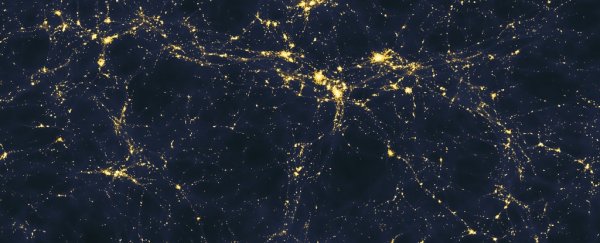The Universe is expanding, and that expansion is speeding up over time. These two facts have been well established through observation, but we don't know what's causing that expansion. It seems to be some mysterious, unknown energy that acts like the opposite of gravity.
We call this hypothetical energy "dark energy", and it's been calculated to constitute around 72 percent of all the stuff that makes up the Universe. We don't know what it actually is. But a new experiment has just allowed us to rule out one more thing that it isn't: a new force.
"This experiment, connecting atomic physics and cosmology, has allowed us to rule out a wide class of models that have been proposed to explain the nature of dark energy, and will enable us to constrain many more dark energy models," said physicist Ed Copeland of the University of Nottingham.
The Universe is a huge and complicated place, but as far as we've been able to ascertain, it's governed by just four fundamental forces. That's the strong nuclear force, the weak nuclear force, electromagnetic force, and gravitational force.
But there are some observational anomalies that don't fit well into existing theories or models of how the Universe works. The hypothetical "fifth force" is the handy basket scientists use to put those anomalies.
Like dark energy, we don't actually know what this force is, but those observational anomalies have allowed constraints to be placed on the fifth force. In turn, this has allowed for the formation of theoretical alternatives to general relativity, in an effort to explain the accelerating expansion of the Universe. Amongst such alternatives are chameleon theory and symmetron theory, for example.
Some physicists have also proposed that dark energy could be the fifth force. And it's this premise that the researchers sought to test here.
If there were a force out there in the Universe accounting for nearly three-quarters of its mass-energy density, you'd think it would be pretty easy to spot. But if it's the opposite of gravity - a repulsive force, rather than an attractive one - it might also stand to reason that it's weakest where gravity is strongest.
Where would that be? Around objects with significant mass. Like, for instance, a planet - therefore the force would be too weak to detect on Earth, or in an experiment using two large weights. But it would be much stronger in the vacuum of space.
So the team designed an experiment to see if they could observe this opposite-gravity force. In a sealed vacuum chamber, they placed a larger weight (an aluminium sphere the size of a marble) and a much smaller one (single atoms of rubidium-87), and used atom interferometry to measure the acceleration of the atom towards the larger mass.
If there was a fifth force acting between the sphere and the atom, the atom would slightly veer off its path as it passed the sphere.
But this deviation was not observed, indicating that there was no unknown force at play in the chamber.
This doesn't mean there is no fifth force at all. But it does mean that constraints can be placed on what that fifth force is, and what dark energy is - which, in turn, means constraints can be placed on chameleon and symmetron theories.
It's like a cosmic game of Guess Who?: figuring out the right questions to ask, then how to ask them, to narrow down the suspects.
And, as physicist Ed Hinds of Imperial College London noted: "It is very exciting to be able to discover something about the evolution of the Universe using a table-top experiment in a London basement."
The research has been published in Physical Review Letters.
